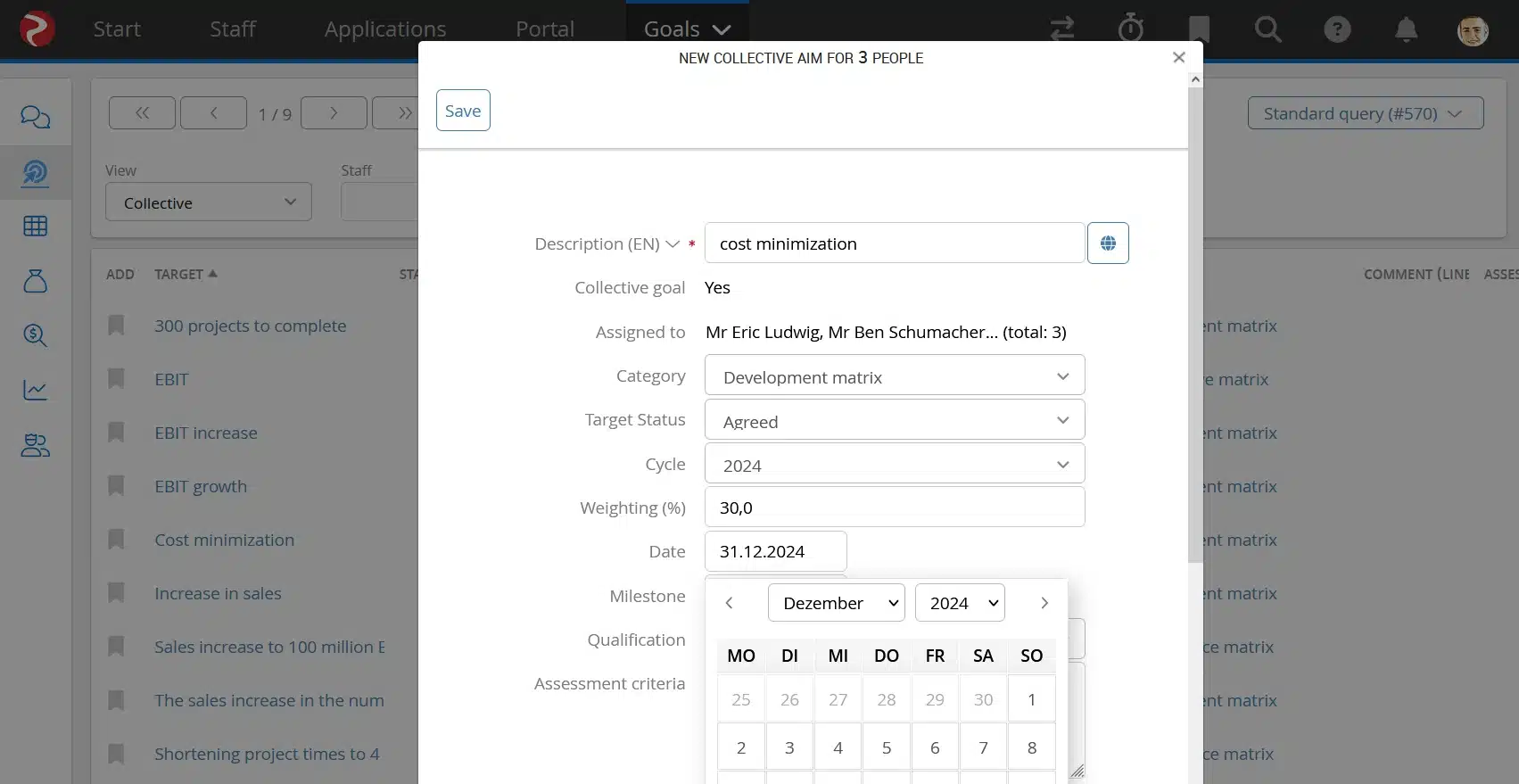Management by Objectives in the Rexx software
Fair and performance-focused target objectives motivate your employees and measurably increase your company success.
The Management by Objectives software from Rexx Systems is a module of the Rexx Talent Management Software and is directly integrated into the Rexx software module for employee appraisals. In addition, there are interfaces to other modules within the Rexx suite – for example to the applicant management software, the digital competence and training management of your company as well as to administrative IT modules.
With the Rexx target agreement software, you define measurement criteria and milestones for target achievement in a differentiated form. The Rexx goal agreement software enables you to define the performance and development goals of your employees individually and precisely. It ensures objective evaluation standards and thus fairness. With this, you promote motivation and job satisfaction of your employees, productive cooperation in your team and thus also the implementation of the corporate strategy. The digital support provided by the Rexx goal agreement software includes all processes that are relevant for setting goals and monitoring their implementation:
- The administrative preparation of target achievement meetings is completely taken over by the software. Appointment planning and the sending of invitations and appointment reminders are automated. Confirmations or change requests can be entered via your company’s self-service portal.
- All information on the agreed goals as well as deadlines and dates for goal achievement are logged by the Rexx goal agreement software.
- With the help of the system’s search & list engine, you can get an overview of the status of your employees’ goal achievement at any time. Performance developments are documented over a longer period of time. Extensive analysis functions are available for evaluating this data. This also makes it possible to compare individual target achievement with departmental and company targets.
- The integrated bonus matrix links bonuses and other performance-related gratuities directly to the digitally documented results of feedback and target achievement meetings. The calculation of bonuses is automated, and the implementation of individual goals can be weighted flexibly for this purpose.
- The skill management system compares target agreements and performance appraisals with the performance and competence requirements of your employees – including an alarm function if any of your people show problems in achieving their targets, so that corrective and employee development measures can be initiated promptly.
Setting objectives
Deadlines and appointments can be entered in Rexx Management by Objectives. Define which management staff and employee are to participate in an individual review. Agree on a feedback discussion or consultation in which, for example, advanced training measures can be discussed.
Flexible rating matrix
Set target objectives by weighting the individual points and linking them with the flexible rating matrix. An intelligent set of rules provides you with support in calculating ratings. Ratings can be directly associated with the digitally documented employee appraisal.
Monitor development
Have the target objectives of the employee and the superiors assessed and documented for the following year. A clear analysis function makes it possible for you to compare and analyse agreements on objectives at any point in time. This thus allows you to determine the up-and-down trends and the development of individual employees – over a longer period of time too.

FAQ Management by Objectives
Management by Objectives are a management technique that aims to define the performance contribution of individual employees to the achievement of company goals. Target agreements are concluded between the managers – usually the direct supervisors – and the employees. In addition to the overall corporate goals, sub-goals of divisions, departments or project teams also play a role in defining their content. The employees’ personal career and development aspirations also flow into the individual target agreements – the important thing here is to achieve consistency with the higher-level goals (team, department/division, overall organisation).
The concept of using target agreements as a management tool is the basis of “Management by Objectives”, the concept of which was developed in the 1950s by the US management scientist Peter Drucker. This is a so-called transactional style of leadership, which serves to optimise the efficiency of companies by defining goals and agreeing on objectives that management and employees have agreed upon.
“Management by objectives” links corporate goals with individual employee goals. The achievement of objectives can be evaluated on the basis of measurable basic variables, but also on the basis of “soft” criteria – such as the improvement of customer orientation or social competences.
Management by Objectives
- create clarity – bosses and employees know the goals that are relevant for a given planning period.
- ensure commitment – they are based on a consensus between managers and employees.
- they enable prioritization – all those involved know which goals are to be achieved, when and for what reasons.
- are an important instrument for staff motivation – performance appraisals are fact-based and not arbitrary.
- promote the assumption of responsibility and personal initiative – employees help decide which goals they want to achieve and with which measures. This gives them more freedom to make decisions in their daily work, which supports their motivation and commitment to the company.
For managers, target agreements provide a good basis for performance appraisals as well as for managing performance and team processes. They also have the opportunity to delegate tasks in an “institutionalised” form and thus to promote individual employees in a targeted manner. Often, the target agreement meetings are also an occasion to resolve existing problems and conflicts.
However, there is always criticism of target agreements and the management concept on which they are based. Critics say, for example, that “management by objectives” primarily promotes performance pressure and competitive behaviour, which limits the creativity of employees and has a negative influence on the working atmosphere.
Further questions concern consequences on regard to unachieved goals – they often remain unachieved – or the agreement of goals whose implementation cannot be objectively measured. Standardized performance and target achievement assessments according to Jack Welch’s 20-70-10 formula, which envisages rewarding 20% of employees, moderately promoting 70% and firing the weakest 10%, also fail to serve their purpose. In order to optimize the productivity of the company and its employees, target agreements must be handled professionally and individually at the same time, from target definition to feedback on target achievement. A powerful target agreement software can make a significant contribution to this.
Target agreements are part of the staff appraisals in companies. The classic occasion for this is the annual target discussions, which are standard in most companies. The agreement of individual goals also plays an essential role in appraisal interviews or employee interviews for individual career planning – for example, for the long-term development of talent or due to changes in the organisational structure of the company.
The target agreement discussion comprises two components:
- As-is analysis/feedback: This part of the discussion deals with the analysis of the actual state, feedback and a performance appraisal of the employee. It also includes questions of job satisfaction and critical points from the employee’s perspective.
- Target agreement: Subsequently, the current company goals and resulting individual performance goals are discussed. On this basis, an individual target agreement is reached. Individual development and career goals are also included in the target agreement.
Target agreement discussions are usually conducted by the direct supervisors. After the completion of the agreed period for the implementation of the goals, the manager and the employee meet for a goal achievement discussion, which follows the same structure.
Managers should frame these discussions as an active dialogue and conduct them on the basis of valid information about the company and departmental goals as well as the past performance of their employees. It is important that employees are also included in the definition of the targets, that they can make their own suggestions and also express requests for changes with regard to the targeted goals. Without an atmosphere of trust, such a dialogue cannot be established – openness and positive communication play a particularly important role in successful target achievement and feedback discussions.
It is important to define the goals for your employees as well as the measures to achieve them as concretely as possible. The SMART criteria provide guidance for managers. They originate from project management, but their application has also become established for the definition of employee goals. Meaningful goals must have the following characteristics:
- S = specific
- M = measurable
- A = accepted
- R = realistic
- T = terminated
In principle, managers and employees should have an identical understanding of the agreed goals and the criteria for achieving them. The goal-setting meeting serves not least to reach agreement on this – which also means that managers and employees must have enough time to talk about this. When scheduling the talks, it makes sense to plan a time buffer so that the discussion of important points is not interrupted due to time constraints.
In addition, a good target achievement meeting requires detailed and intensive preparation. Managers need to know the company’s objectives, the sub-objectives derived from them, including the targets for budget management, but also the individual performance of their employees. The Rexx software provides optimal support here by making it possible to call up employee and performance data in a focused manner. This includes, for example, previous performance appraisals, previous target agreements and the status of target achievement, individual performance indicators or an overview of personnel development measures already completed.
Successful target agreements combine individual performance goals with personal development goals. The latter make an explicit contribution to employee motivation and sustainable employee loyalty.
Employees can set quantitative or qualitative performance goals in consultation with their superiors. The implementation of quantitative goals can be measured relatively easily using KPIs (Key Performance Indicators). Managers often give these goals a special priority: on the one hand, they simplify the assessment of employee performance, and on the other hand, the performance of managers is often measured against such KPIs – for example the fulfillment of production, sales or turnover targets. Qualitative performance goals relate, for example, to optimizing customer contacts or customer loyalty. Compared to quantitative goals, their fulfillment is much more difficult to measure – superiors have subjective discretion here. Specific measures and the evaluation criteria for achieving the goals should also be discussed in the target agreement discussion. It is good when target agreements contain a balanced mix of qualitative and quantitative goals. The number of goals should generally remain manageable: management experts recommend limiting yourself to agreeing on a maximum of five goals.
Personal development goals can be defined with different focuses, and employees’ personal career aspirations are also taken into account here:
- Qualification goals serve to systematically develop talents who are to be prepared for a new position and taking on greater responsibility. Measures to achieve goals are further education measures or training “on the job” – for example through the independent implementation of larger projects.
- Retention goals make it possible to bind top performers to the company even more strongly than before. Examples of this include attending specialist conferences or supporting individual further training wishes – such as a part-time master’s degree. They therefore have the character of recognition and gratification.
- Change goals are agreed upon in order to eliminate performance deficits or to prepare employees for changes in the content of their work tasks. The development of soft skills and leadership skills are included here. Typical measures to achieve goals include training, seminars and individual coaching.
Just as with regard to performance goals, it also applies to development goals that the target agreements should be concluded in as much detail as possible and employees have the opportunity to express their individual development wishes.
The period for which target agreements apply depends on the type of goals. They are often met for one year at a time, and the employees then only receive feedback in the next annual meeting. In many companies, however, goal achievement discussions are also common at shorter intervals in order to respond promptly to problems and changing conditions. However, if the target agreements include the completion of a project during the year, the completion of a personnel development measure or the achievement of other important milestones, it is optimal if feedback from the superior occurs immediately afterwards.
Rexx management by objectives Software supports you in transparently setting individual goals for your employees and workflow-controlled performance assessment across the entire company.
The module of the Rexx Talent Management Software enables you to define differentiated measurement criteria and milestones and to check them regularly – and thus also support the successful implementation of corporate strategies.


